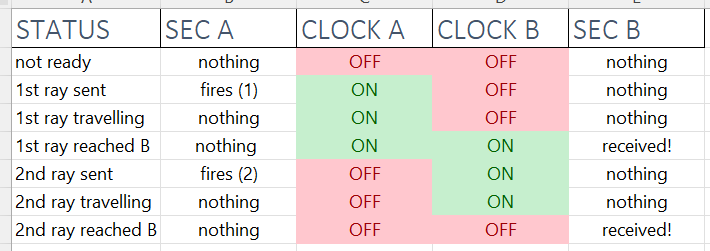By Dewan Mukto Browse All
Licensed under CC BY 4.0 (Unless specified otherwise)
Photo by Christopher Burns on Unsplash
After watching a particular video by Veritasium on YouTube today, I figured I might be able to design a possible way of accurately measuring the speed of light.
I thought, instead of the traditional methods, we could try using LDRs (light-dependent resistors) and electronic circuitry set up in such a way that they don’t need to be in synchrony to be working.
Here’s a highly simplified diagram of what the apparatus would look like.

simplified thematic diagram of the apparatus in question
Instead of measuring the light “reflected back” at the reception object, we could use a LDR that would activate a circuit that starts a timer.
In order to reduce the discrepancies caused by the speed of electricity, we could construct the two electronic circuits as “nanochips” — as small as possible so that the effect of light acting on the LDRs is almost instantaneous. The material that the LDR is composed of must also have a super-sensitive threshold for detecting changes in luminosity.
Basically, at section A, a circuit projects a beam of light along a metre (or more) of a pre-measured length along a vacuum tunnel. At the same moment as the ray of light is generated, a clock/timer connected to section A’s circuitry is brought to life, ticking away at the critical microseconds.
At section B, an array of several homogenous LDRs await with their surfaces anticipating the arrival of the light ray. As soon as it hits, the circuitry at B starts its own timer.
Oh, but the process is not done yet!
Back at section A, another ray of light is dispatched from its homeland. Simultaneously, the clock at A is turned off immediately. When this second ‘light’ reaches the end at section B, the same process happens just like the first one — except that the timer is stopped.
Not getting the point of how it works? No problem! Here’s a tabular form of the procedure and how the ‘sensors’ at both sections are expected to react.

sample “expected” scenario
This method is supposed to provide two very similar results on both clocks. If not, it is always a fundamental pillar of science that any proper experiment needs to be repeated several times.
That’s where the power of statistics comes in, and you just sort out the anomalous results from the rest and have a closer look.
If you think all of this is bogus, I wouldn’t blame you. But for once, just have a go through the main video which inspired me to plan all of this :
And if you’re a professional physicist or someone with a lot of scientific knowledge, if you think my method is a conceivable way of efficiently measuring the speed of light, feel free to reproduce it in the lab. If not, then feel free to lay down your criticism via comments.
Thanks for your time and hope this also inspires you to tackle some “unsolved” or “unsolvable” problems on your own!